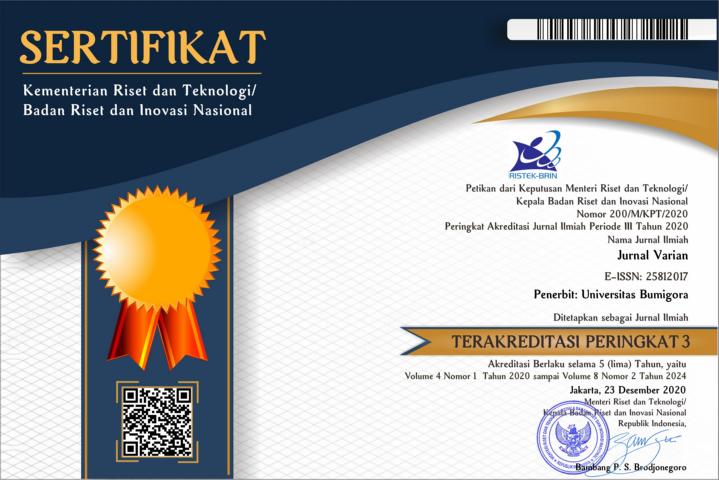Daily Rainfall Forecasting with ARIMA Exogenous Variables and Support Vector Regression
Abstract
There is a seasonal element every year, with the dry season often lasting from May to October and the rainy season lasting from November to April. However, climate change causes the changing of the rainy and dry seasons to be erratic, so it is necessary to anticipate weather conditions. Prediction of rainfall is used to see natural conditions in the future with time series modeling. The rainfall modeling method at the six Surabaya observation posts used is the Autoregressive Integrated Moving Average with exogenous variables (ARIMAX) and Support Vector Regression. The exogenous variable used is the captured seasonal pattern of rainfall. The SVR model uses input lags from the ARIMAX model and parameter tuning uses the Kernel Radial Based Function. Selection of the best model uses the minimum RMSE value. The results showed that the average occurrence of rain at the six rainfall observation posts occurred in January, February, March, April, November and December. The ARIMAX method in this study is well used to predict rainfall in Gubeng and rainfall in Wonorejo. The SVR input lag ARIMAX method is good for predicting rainfall for Keputih, Kedung Cowek, Wonokromo and Gunung Sari. Nonparametric methods are better used to forecast rainfall data because they are able to capture data patterns with greater volatility than parametric methods, one of which is the SVR method.
References
1722/1/012061.
Amelia, R., Dalimunthe, D., Kustiawan, E., and Sulistiana, I. (2021). Arimax model for rainfall forecasting in pangkalpinang,
indonesia. In IOP Conference Series: Earth and Environmental Science, volume 926, page 012034. IOP Publishing. https:
//doi.org/10.1088/1755-1315/926/1/012034.
Dabral, P. and Murry, M. Z. (2017). Modelling and forecasting of rainfall time series using sarima. Environmental Processes,
4(2):399–419. https://doi.org/10.1007/s40710-017-0226-y.
Dani, A. T. R., Wahyuningsih, S., Putra, F. B., Fauziyah, M., Wigantono, S., Sandariria, H., A’yun, Q. Q., and Zen, M. A. (2023).
Aplikasi model arimax dengan efek variasi kalender untuk peramalan trend pencarian kata kunci zalora pada data google trends.
Inferensi, 6(2):107–116. https://doi.org/10.12962/j27213862.v6i2.15793.
Gautam, A. and Singh, V. (2020). Parametric versus non-parametric time series forecasting methods: A review. Journal of Engineering Science & Technology Review, 13(3). https://doi.org/10.25103/jestr.133.18.
Makridakis, S., Spiliotis, E., and Assimakopoulos, V. (2020). The m4 competition: 100,000 time series and 61 forecasting methods.
International Journal of Forecasting, 36(1):54–74. https://doi.org/10.1016/j.ijforecast.2019.04.014.
Nanlohy, Y. W. A., Brodjol Sutijo, S., et al. (2019). Model fungsi transfer multi input untuk peramalan curah hujan di kota surabaya.
VARIANCE: Journal of Statistics and Its Applications, 1(2):82–92. https://doi.org/10.30598/variancevol1iss2page82-92
Nanlohy, Y. W. A. and Haumahu, G. (2021). Model autoregressive integrated moving average (arima) untuk peramalan curah hujan
di kota surabaya. Tensor: Pure and Applied Mathematics Journal, 2(1):25–32. https://doi.org/10.30598/tensorvol2iss1pp25-32.
Nisa, C., Sumarjaya, I. W., and Srinadi, I. (2021). Penggunaan model arimax untuk meramalkan data curah hujan bulanan di bali.
EJ. Mat, 10(4). https://doi.org/10.24843/MTK.2021.v10.i04.p341.
Ray, S., Das, S. S., Mishra, P., and Al Khatib, A. M. G. (2021). Time series sarima modelling and forecasting of monthly
rainfall and temperature in the south asian countries. Earth Systems and Environment, 5:531–546. https://doi.org/10.1007/
s41748-021-00205-w.
Riyani, D., Prastyo, D. D., and Suhartono, S. (2019). Input selection in support vector regression for univariate time series forecasting.
In AIP Conference Proceedings, volume 2194. AIP Publishing. https://doi.org/10.1063/1.5139837.
Siswanti, T. E. and Yanti, T. S. (2020). Pemodelan arimax (autoregressive integrated moving average with exogenous variable).
Prosiding Statistika, 6(2):113–118. https://dx.doi.org/10.29313/.v6i2.
Suci, K. W. and Irhamah, I. (2017). Peramalan curah hujan sebagai pendukung kalender tanam padi di pos kedungadem bojonegoro
menggunakan arima, support vector regression dan genetic algorithm-svr. Jurnal Sains dan Seni ITS, 6(1):D157–D163. https:
//doi.org/10.12962/j23373520.v6i1.22092.
Suhermi, N., Suhartono, Permata, R. P., and Rahayu, S. P. (2019). Forecasting the search trend of muslim clothing in indonesia on
google trends data using arimax and neural network. In Soft Computing in Data Science: 5th International Conference, SCDS 2019,
Iizuka, Japan, August 28–29, 2019, Proceedings 5, pages 272–286. Springer. https://doi.org/10.1007/978-981-15-0399-3 22.

This work is licensed under a Creative Commons Attribution 4.0 International License.


















